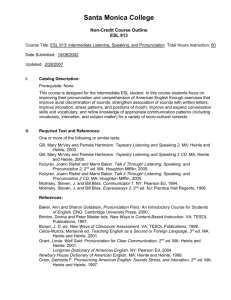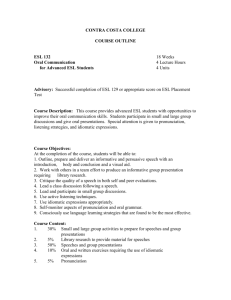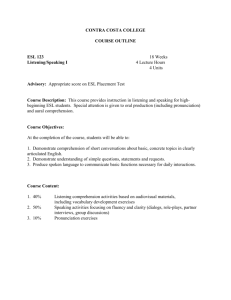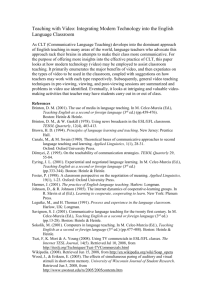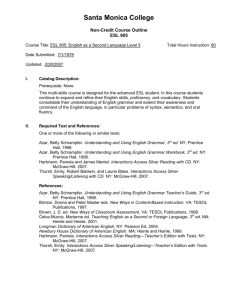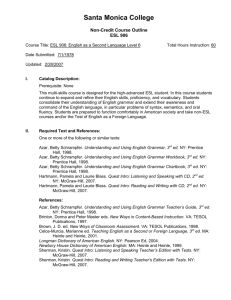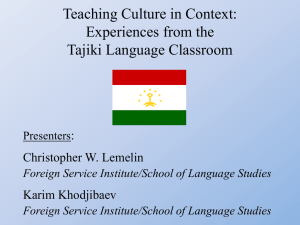915 - Santa Monica College
advertisement
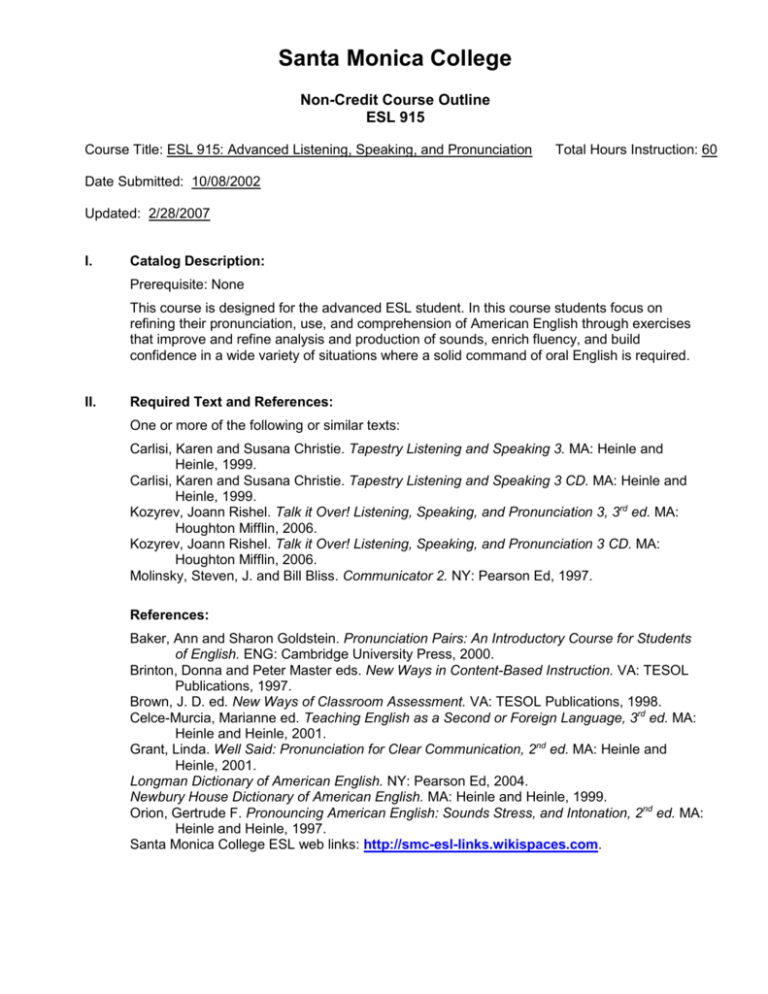
Santa Monica College Non-Credit Course Outline ESL 915 Course Title: ESL 915: Advanced Listening, Speaking, and Pronunciation Total Hours Instruction: 60 Date Submitted: 10/08/2002 Updated: 2/28/2007 I. Catalog Description: Prerequisite: None This course is designed for the advanced ESL student. In this course students focus on refining their pronunciation, use, and comprehension of American English through exercises that improve and refine analysis and production of sounds, enrich fluency, and build confidence in a wide variety of situations where a solid command of oral English is required. II. Required Text and References: One or more of the following or similar texts: Carlisi, Karen and Susana Christie. Tapestry Listening and Speaking 3. MA: Heinle and Heinle, 1999. Carlisi, Karen and Susana Christie. Tapestry Listening and Speaking 3 CD. MA: Heinle and Heinle, 1999. Kozyrev, Joann Rishel. Talk it Over! Listening, Speaking, and Pronunciation 3, 3rd ed. MA: Houghton Mifflin, 2006. Kozyrev, Joann Rishel. Talk it Over! Listening, Speaking, and Pronunciation 3 CD. MA: Houghton Mifflin, 2006. Molinsky, Steven, J. and Bill Bliss. Communicator 2. NY: Pearson Ed, 1997. References: Baker, Ann and Sharon Goldstein. Pronunciation Pairs: An Introductory Course for Students of English. ENG: Cambridge University Press, 2000. Brinton, Donna and Peter Master eds. New Ways in Content-Based Instruction. VA: TESOL Publications, 1997. Brown, J. D. ed. New Ways of Classroom Assessment. VA: TESOL Publications, 1998. Celce-Murcia, Marianne ed. Teaching English as a Second or Foreign Language, 3rd ed. MA: Heinle and Heinle, 2001. Grant, Linda. Well Said: Pronunciation for Clear Communication, 2nd ed. MA: Heinle and Heinle, 2001. Longman Dictionary of American English. NY: Pearson Ed, 2004. Newbury House Dictionary of American English. MA: Heinle and Heinle, 1999. Orion, Gertrude F. Pronouncing American English: Sounds Stress, and Intonation, 2nd ed. MA: Heinle and Heinle, 1997. Santa Monica College ESL web links: http://smc-esl-links.wikispaces.com. Santa Monica College Non-Credit Course Outline Page 2 of 4 III. Objectives: Upon completion of the course students will be able to: IV. A. Use advanced English vocabulary to produce complex sentences. B. Orally initiate and respond in English to multi-part commands and questions. C. Distinguish aurally between English phonemes and similar-sounding words. D. Pronounce the sounds of letters, diphthongs, and similar-sounding words. E. Consistently produce correct intonation and stress patterns for statements, questions, and exclamations. F. Initiate and respond in English to complex conversational cues. G. Converse ably and in a culturally-appropriate manner in a variety of situations and settings. H. Paraphrase a complex idea or thought using appropriate synonyms and definitions. I. Identify main ideas and supporting details in two- or three-minute listening passages. J. Demonstrate improved confidence using all tenses in conversation. K. Compare and contrast traditions and customs in American and other cultures. L. Demonstrate appropriate job interview skills. M. Effectively produce commonly used idiomatic expressions. N. Respond orally to advanced audio or video-taped assignments. O. Use transition words and various word forms in short presentations. P. Use correct subject-verb agreement and singular-plural inflections in short presentations. Q. Analyze advanced new vocabulary and make inferences according to context and other cues. R. Discuss various current events using related English vocabulary. S. Make oral presentations in English. Student Learning Outcomes: Date Submitted: 2/28/2007 1. Students will make a 2-3 minute oral presentation about a current event using related vocabulary and transition words, and employing correct subject-verb agreement and singular-plural inflections. 2. In a mock job interview, students will present their background and experience, skills, and career goals using related vocabulary and employing appropriate tenses. Santa Monica College Non-Credit Course Outline Page 3 of 4 V. Instructional Methodology: (Approximate values are shown, but because all non-credit ESL courses are open entry / open exit, actual percentage values may vary.) 20% 40% 10% 15% 10% 5% VI. Lecture and/or demonstration Speaking and listening exercises (including class discussions, small-group discussions, pair activities, oral recitations, and/or threaded discussions) Reading and writing exercises (including error analysis and/or paraphrasing) Student presentations and/or oral recitations Audio-visual materials and/or guest speakers Computer-assisted learning Course Content: (Approximate values are shown, but because all non-credit ESL courses are open entry / open exit, actual percentage values may vary.) Percentage of Term Topics Listening skills, including English phonemes and similar-sounding words, 30% multi-part commands, English conversational cues, advanced English vocabulary, complex grammatical structures, complex phrases used in real-life contexts, intonation and stress patterns, synonyms, verb tenses, how to identify the main idea, topic sentence, and supporting ideas, elements of conversation, idiomatic expressions, subject-verb agreement, singular-plural inflections, transition words, word forms. Speaking skills, including advanced English vocabulary, complex 30% grammatical structures, complex phrases used in real-life contexts, intonation and stress patterns, synonyms, verb tenses, responses to multipart commands, following complex conversational cues, elements of conversation, subject-verb agreement, singular-plural inflections, transition words, word forms, making an oral presentation, discussions of current events, making oral presentations. Pronunciation skills, including positions of mouth, English phonemes 30% and similar-sounding words, advanced English vocabulary, intonation and stress patterns. 10% American culture, including appropriate responses to a wide variety of cultural situations and contexts, conversational etiquette, American holidays, American traditions, job interview skills. Santa Monica College Non-Credit Course Outline Page 4 of 4 VI. Methods of Evaluation: (Approximate values are shown, but because all non-credit ESL courses are open entry / open exit, actual percentage values may vary.) 40% 15% 15% 10% 20% Oral presentations Quizzes and exams Homework assignments Writing assignments Participation in classroom discussions and activities (including reading exercises, oral recitations, small group work, pair work, and threaded discussions) Curriculum Approved ________ Date David Zehr, Chair, Curriculum Committee Date Jeff Shimizu, Vice President, Academic Affairs
